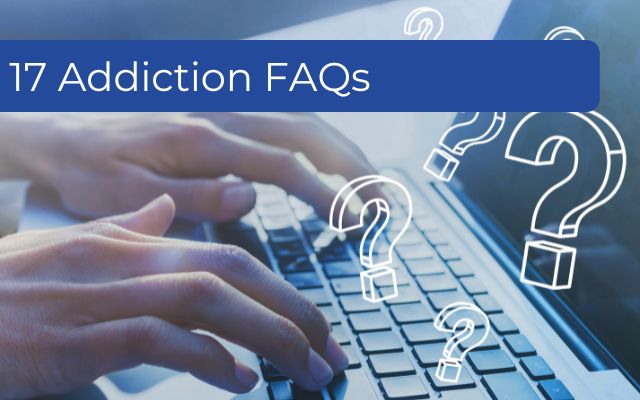
When it comes to addiction, there are so many questions you might be asking yourself and be unsure of the answers to, that’s why we’ve put together a list of some of the most common addiction FAQs. Our list is currently sitting at 17, and if your question isn’t here, add it to the comments section for us.
Here are the addiction FAQs – 17 frequently asked questions and answers
1. Why do addicted people continue to use even when it hurts them?
Addicted people have lost control over their actions. They crave and seek out drugs, alcohol, or other substances at any cost. It is a common misconception that addiction is a choice or indeed a moral failing. Research shows that the brain changes with addiction and concentrated treatment is required to return the brain to a normal state. The more intense and prolonged the use of substances the more disruption is caused to the brain.
Drugs and alcohol hijack the pleasure and reward circuits in the brain and seduce the user into wanting more and more. Addiction also sends out distress signals when the user has not had their fix and feelings of anxiety flood their systems. This is the stage where using the harmful substance is no longer linked to pleasure but rather to a sense of survival.
When addiction is viewed with clarity as a disease that affects the brain it may help to explain why it is so difficult for the addicted person to stop without proper treatment. Active engagement in treatment is essential and increases the positive outcome for even the most challenging cases.
2. How is substance abuse treated?
The intention of treatment is to help the addicted person to stop compulsive substance seeking and use. There are varying forms of treatment that may differ in facilities, chosen therapy and length of stay. Addiction is a relapsing condition and short-term treatment is seldom sufficient. Optimal treatment is a long-term process that involves constant monitoring and many interventions.
Addiction treatment usually combines evidence-based therapy approaches like Cognitive behavioural therapy (CBT) or contingency management with the inclusion of appropriate medications where required. Combination treatments will differ according to each person’s needs and will consider the substance they abuse.
Medications such as methadone, buprenorphine, and naltrexone are known to be effective in treating individuals addicted to heroin or other opioids. The medication helps to stabilize the person and assists in stopping their illicit drug use. Acamprosate, disulfiram, and naltrexone are medications approved for treating alcohol dependence. People addicted to nicotine often use a nicotine replacement product or an oral medication such as bupropion or varenicline can be an effective component of treatment when part of a comprehensive behavioural treatment program.
Behavioural therapies help to encourage active participation in a treatment programme and offer coping skills that help tackle cravings and avoid triggers. It also teaches people how to deal with relapse so that the problem does not escalate. The crux of therapy is to dismantle old ways of thinking and relating to the world and teach the individual instead how to live in a new way. This assists the person to better the quality of their lives.
Individual, family and group therapies are usually conducted and these sessions serve to teach the individual new skills in all aspects of life but also serve as a base for social reinforcement. The person relates to his or her peers and receives feedback on an ongoing basis which solidifies their resolve to abstain from substance use. The use of group therapy for delinquent teens must be monitored by a trained counsellor as quite often drug use can be inadvertently reinforced and counter the purpose of the group.
Lastly, substance abuse treatment centres should always provide combination treatments per patient. Many people suffer from concurrent illnesses such as infectious diseases (HIV, Tuberculosis, or Hep B or C) or have mental disorders such as Bipolar or PTSD. It is vital that all diagnosed disorders are treated.
3. Is addiction treatment effective?
As with all chronic illnesses, addiction can be treated and managed successfully. The objective of treatment is to help people to reintegrate into their lives as productive members of society. The goal is ultimately to improve their quality of life.
Research indicates that long-term treatment that is tailored around the individual’s specific needs and includes consistent assessment, monitoring and correct medication where required, yields positive results.
It has been shown that people who actively participate in their treatment programmes and remain in the process for the duration tend to have better outcomes. Individual results however will depend on the nature and extent of the person’s issues as well as the efficacy of the treatment plan put in place by treatment providers.
Treatment enables and motivates people to resist the disturbing effects of addiction and allows them to take back their lives. However, as with other comparable chronic illnesses like diabetes or hypertension, relapse is not only possible but likely probable. This is not an indication of failure but rather causes to adjust the treatment plan or try an alternative. As with all other chronic illnesses, symptoms can be brought under control but will from time to time require adjustment or modification as the body and situations change.
4. How long does addiction treatment last?
There is no cut and dried length of time for an individual to progress through treatment. However, research suggests that participation in either an outpatient or residential programme for less than 90 days seriously diminishes the efficacy of treatment. Longer-term treatment is always more beneficial and promotes positive outcomes.
Generally, methadone maintenance is monitored over a period of 12 months but addicted persons can benefit from this treatment over many years.
Effective treatment uses motivational techniques to keep patients interested in their recovery and with the high early dropout rate this is a vital aspect of improving the eventual outcome. programmes may need to be adjusted or re-admittance into treatment may be necessary for relapsed patients.
5. What motivates people to stay in treatment?
The successful outcome of treatment strongly relies on the individual staying the course in order to gain its full benefits. It is crucial to utilize all available strategies to keep the person in treatment for as long as possible.
The person’s motivation to change their using behaviour may be strongly guided by support from family and friends and may provide encouragement to engage and retain information during the treatment process. This is also true of pressures that can come from the courts, child welfare and employers.
Treatment should include a full support staff of medical, psychiatric and social services. Clinicians should establish positive therapeutic relationships and develop a treatment plan together with the patient. The clinician should make sure that expectations are understood and met.
The inclusion of individual problems such as serious medical or mental illness issues or criminal activity increases the chances of a person dropping out of the programme. In these instances, it is suggested that radical interventions are utilized to keep the person in treatment. Continuing care and monitoring should be part of the person’s ongoing recovery.
6. How can family and friends help a person needing treatment?
The support of loved ones is critical in motivating people with substance abuse issues to stay in treatment. Family therapy is also crucial and especially so for teens. The commitment of loved ones can help to extend and bolster treatment benefits.
7. How can the employer play a role in substance abuse treatment?
Many employers have established substance abuse programmes in an attempt to respond to the problems and aftermath experienced in the workplace. These programmes are designed to save money, careers, families and lives. In an endeavour to raise awareness surrounding the impact of substance abuse in the workplace, the ILO (international labour organization) implemented its code in 1995. Although dated, it is still fitting and can help employers develop and maintain a substance-free workplace. Employers would benefit greatly by applying this type of policy. The failure to do so may result in adverse effects on productivity, the business and its employees.
8. What are the different needs of women with substance use disorders?
When treating women with substance use disorders it is important to take into consideration not only biological differences but also social and environmental factors. Research shows that physical and sexual trauma with subsequent PSD (post-traumatic stress syndrome) is far more common in addicted women than men. Factors unique to women that may influence the treatment process includes how treatments sought financial stability as well as pregnancy and / or childcare.
9. What are the needs of pregnant women with substance use disorder?
The use of alcohol, drugs or tobacco during pregnancy may pose a serious threat to the health and well-being of both the mother and developing foetus. The harmful effects of substance abuse on children may increase the risk of stillbirth, infant mortality, SIDS (sudden infant death syndrome) low birth weights and a host of other complications. Drinking during pregnancy may cause foetal alcohol spectrum disorder (FASD) which includes low birth weight and a spectrum of cognitive and behavioural issues that are long term problems.
Opioids and some other substances may cause withdrawal symptoms in the newborn child and this is referred to as neonatal abstinence syndrome (NAS). These children are at risk of feeding difficulties, seizures, low birth weight and in some instances death.
There are various evidence-based treatments that are reported to be of help to the mother and child during pregnancy. These methods do include medication. Methadone for the treatment of opioid abuse in conjunction with prenatal care and a treatment programme has been known to reduce the harmful outcomes of untreated heroin abuse. The child will however still suffer from methadone withdrawal at birth. Buprenorphine has recently shown fewer NAS symptoms in babies than in those treated with Methadone.
On the whole, a woman seeking drug abuse treatment during pregnancy requires close monitoring and very specific and evidence-based care.
10. Are the treatment protocols different for older people?
Substance abuse is a problem for the user and their loved ones at any age and getting treatment is particularly crucial for the elderly, who are likely to have complications that the younger generation may not. Treatment for older populations is be based on the same modality as for younger people but it is essential to find clinicians who are experienced in treating issues that affect older people competently and sensitively.
The older population may not be the first associated with substance abuse yet increasingly more and more older people are becoming addicted to medications originally prescribed for legitimate reasons, some have been functionally addicted to other substances including alcohol for an extended period of time and only begin to show more obvious signs as they get older. The effects of ageing and life circumstances including, the death of a loved one, loneliness and retirement are all factors that are known to contribute to abuse disorders that begin later in life.
Full-spectrum treatment including medical observation; along with consistent assessment and monitoring should be available in treating the elderly.
11. Can a person become addicted to medications prescribed by a doctor?
Addiction to prescription medication like sleeping pills and tranquillizers is far more common than some addictions to illicit drugs. In the use of these prescription medications the body may build up a tolerance and the dose may need to be increased to achieve the same results. The most frequently abused prescription and over-the-counter medicines include opioids such as hydrocodone (Vicodin) and oxycodone (OxyContin, Percocet), sleep medicines such as zolpidem (Ambien) and eszopiclone (Lunesta), and stimulants such as methylphenidate (Concerta, Ritalin).
The person may be physically dependent on a prescription medicine if the body has adapted to the effects to the point that stopping its use causes withdrawal symptoms. The only way to get through this stage is to slowly reduce the dosage, under a doctor’s supervision, to prevent severe symptoms of withdrawal.
In a small percentage of people, addictive behaviours may develop during treatment with narcotics or tranquillizers. In these circumstances, it is important to seek treatment.
12. Is there a difference between addiction and physical dependence?
There is a difference between physical dependence and addiction yet it can be difficult to understand as the statements are often used interchangeably.
The term dependence in this instance refers to a physical dependence on a substance and is characterized by symptoms of tolerance and withdrawal. It is possible to be dependent without being addicted yet when this state occurs in a person addiction is often not far behind.
Addiction is characterized by a marked change in behaviour which is caused by chemical changes within the brain with repeated abuse of a substance. The constant craving and seeking of a particular substance regardless of the negative consequence not only to the person but those around them. Addiction is noted to cause irrational behaviour when the substance of abuse is not available to the person.
13. Can co-occurring mental disorders affect substance abuse treatment?
In the event of co-occurring disorders (often referred to as a dual diagnosis), an integrated approach to treatment is best. Both the substance use issue and the mental disorder must be treated concurrently. Long-term recovery depends on receiving treatment for both disorders. Treatment will be determined by taking into consideration the nature of the mental disorder as well as the type of substance abused.
14. Is using medications like methadone or buprenorphine replacing one addiction for another?
Medications prescribed for the treatment and maintenance of opioid addiction are administered under controlled conditions and are effective in treating this addiction when used as directed.
Methadone and buprenorphine are not used to substitute heroin or opioids when used as a maintenance treatment. The euphoria and high associated with the use of the illicit drug are not present. The medication is known to reduce the desire to use opioids. In the event that a person on treatment attempts to use an opioid, the euphoric effects are usually depressed.
People who partake in the maintenance treatments seem to have none of the physiological or behavioural issues usually associated with the use of heroin. Maintenance treatments save lives and allow people to regain their lives and become effective and productive members of society.
15. Where do the 12 steps or other self-help programmes fit into substance abuse treatment?
12 step and other self-help groups can be particularly helpful during and after treatment. These groups offer an added benefit to long–term recovery as they create a support base within a community of people that share the same end goal; to abstain from drugs and to live a healthy and productive life.
The leading self-help groups are those associated with Alcoholics Anonymous (AA), Narcotics Anonymous (NA), and Cocaine Anonymous (CA), all of which are based on the 12-step model. Most substance abuse treatment programs encourage patients to participate in self-help group therapy during and after formal treatment.
16. Does exercise help in the treatment process?
Exercise is an increasingly more common component of treatment and has proven effective when combined with other treatment measures. While it is true that not everybody enjoys a workout it most certainly can be beneficial as a tool in rebuilding a healthy life. A study published in Frontiers of recovery 2011 shows evidence that exercise can deter the use of illicit drugs.
In a similar vein, results from a survey conducted by the National Institute of Drug Abuse showed that high school students who exercise regularly were less likely than their more inactive counterparts to smoke cigarettes or abuse marijuana.
A study published by the Scandinavian Journal of Public Health found that people who incorporated exercise into their treatment programs reported reduced intake of drugs and improved quality of life. Participants said they felt more energetic, could breathe easier and felt better about their appearance.
17. How does addiction treatment reduce the spread of HIV, Hepatitis C and other infectious diseases?
People who abuse substances are at an increased risk of contracting HIV (Human immunodeficiency virus), Hepatitis C and other infectious diseases. Both injecting and non-injecting users are at risk. These infectious diseases are spread through the sharing of used needles and by risky sexual behaviour.
Effective treatment programmes help to prevent the spread of these diseases as they reduce drug-related activities by educating and testing the users. Education and counselling focused on the risk behaviours add a level of disease prevention.
Quality treatment programmes offer screening to encourage early detection and referral for HIV treatment is necessary.

